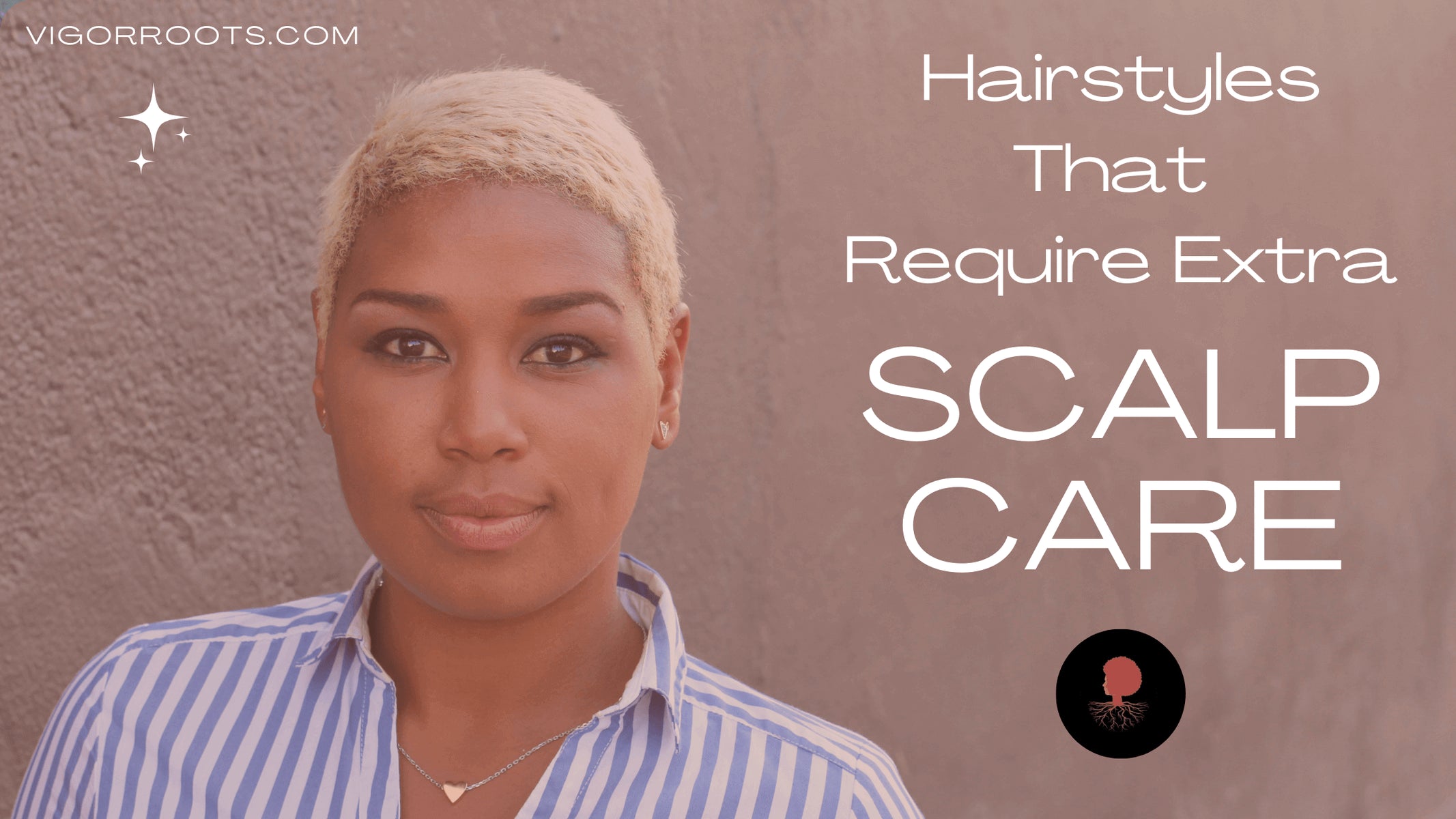
Wanna know a secret that shouldn’t be a secret? Many popular hairstyles require an amped-up scalp care routine in order to prevent hair damage and loss.
Do you rock any of the following?
- Bleach
- Dye
- Perms/chemical straightening
- Hair styled or dried with a high heat setting
- Wigs
- Weaves
- Box braids, twists, or other protective hairstyles
- Tight ponytails, buns, or other tension styles
Awesome, we bet these styles look great on you! But, to keep your hair and scalp healthy, there are a few things you need to know. Read on for advice we wish our mothers had told us, and their mothers had told them.
Leave It To The Professionals
Were you about to go blonde or straighten your tresses? We’re not here to stop you, we just want to empower you to do it in a way that won’t harm the long-term health of your hair and scalp.
First and foremost, unless you yourself are a professional stylist, don’t attempt to dye, bleach, or chemically process your hair yourself.
Why? Because if you improperly apply chemicals, leave them in too long, or subject already brittle hair to a harsh chemical or heat process, the results can be disastrous. From giving your scalp a chemical burn to accidentally melting off your hair, there are so many ways this can go wrong. (Follow the links and Google this if you want, but the results aren’t for the faint of heart.)
Having a reputable stylist handle your hair transformation makes it much more likely that you’ll be happy with the results.
Don’t Go There If You’re Already Having Hair or Scalp Issues
Do make sure to ask your stylist whether they think your scalp and hair are healthy enough to undergo the procedure.
Ethically, your stylist should tell you when it’s a bad idea. But some are in the “customer is always right” camp and might not tell you if your scalp is too dry and irritated or your hair too brittle for things to turn out well… unless you ask them directly.
Look, they tend to make a pretty penny if you’re asking for mermaid hair, to go from opposite ends of the shade or texture spectrum, etc. So, if your stylist tells you, “I wouldn’t”- don’t.
Any Style That Dries Out The Scalp Means You Need More Scalp Care
OK, let’s say your stylist gives you a clean bill of hair health and you go ahead and get that glow up.
Do keep in mind that whenever you put your hair through a harsh chemical process (like dye, bleach, or chemical relaxers), your scalp is likely to experience dryness and some degree of irritation. Same goes for using styling tools and blow dryers on high heat settings.
Even when no chemicals or heat are involved, tension styles ranging from box braids, twists, to tight ponytails, and buns can also lead to the scalp needing some extra care- especially when these styles are left in for quite a while and impede healthy scalp circulation.
So, in order to protect the long-term health of your scalp and hair, it’s important to understand that whenever you’re rocking one of these styles, you’re going to have to put more effort into scalp care than usual.
Proper Scalp Care for Treated Hair
Honestly, everyone needs a scalp care routine.
Even people with 100% naturally styled hair need to wash and condition their hair at least once a week. This is important in order to prevent dead skin cells, natural scalp oils, product build-up, and environmental debris from clogging the pores, causing irritation or infection, and inhibiting hair growth.
The need for this doesn’t go away after your hair transformation or your gorgeous new wig. For this reason, Vigor Roots cautions against glued-in or semi-permanent wig styles that prevent you from washing your hair and scalp at least once a week.
“Your scalp naturally produces oil. When left unwashed, the oil mingles with dirt from the environment and causes damage the longer you leave it there. The hair becomes thinner, more fragile. The dirt and buildup on your scalp are blocking pores and preventing growth. Just imagine if you didn’t wash your face for 4 weeks.”
-Nathalee DuRose, Vigor Roots Founder & CEO
So, regardless of your hairstyle, make sure you’re shampooing and conditioning 1-2 times a week.
And, while it’s important for everyone with all hair types and conditions to moisturize their scalps at least a couple of times a week, whenever you put your hair through a harsh chemical process, high heat, or a tension style- you need to moisturize more frequently.
For those with treated hair, if you’re not seeing any hair thinning or damage, DuRose recommends applying a nourishing, natural scalp serum every other day, or 3-4 times a week in order to keep your scalp healthy and your hair happy.
It’s also important to keep up regular visits to the stylist for hair maintenance, scalp assessments & recommendations, along with a deep conditioning and moisturizing treatment.
Give Your Hair Breaks from Weaves, Wigs, & Tension Styles
Again, it’s not just chemically processed hairstyles that require more frequent scalp care.
Since protective hairstyles don’t involve harsh chemicals, many people don’t realize that they also necessitate closer attention on scalp care. Anytime you inhibit scalp circulation or make it harder to cleanse and moisturize the scalp, you want to carefully monitor for any issues.
Even when you’re not having any scalp problems or hair breakage with wigs, weaves, and protective styles, it’s still important to wash and condition your hair at least once a week and to moisturize the scalp with a natural scalp serum 2-3 times a week, according to DuRose.
And, in order to promote healthy scalp circulation, DuRose recommends giving your hair regular breaks from tension styles. It’s best not to leave a protective style or weave in for longer than 4-6 weeks. DuRose advises then giving your hair a 2-week break before applying another tension style.
Wigs that can be removed nightly are gentler on the scalp than wigs that stay glued on for days or weeks at a time. DuRose recommends removing your wig every night and brushing the tangles out of your hair to prevent matting. Then, apply a nourishing, natural scalp serum and cover your tresses with a satin bonnet while you sleep to help your scalp absorb the moisture it needs.
At the very, very least, DuRose says you should be removing your wig once a week to do a thorough shampoo and deep condition and to apply moisturizing scalp serum.
But, given the convenience of wigs, weaves, and protective styles, a lot of folks go much longer before changing up their hair. Unfortunately, leaving these styles in for too long is a recipe for disaster. DuRose says you can definitely expect matting, knots, hair damage, and an irritated scalp if you go 12 weeks without giving your scalp a break.
If you’ve done this, don’t worry. There’s no shame, a lot of people do- because so many of us were never taught not to. Just give your hair at least a month off from any tension styles, use a moisturizing scalp serum daily, and go to your stylist for a scalp assessment. It’s likely that your hair and scalp health can be restored with proper scalp care.
Take Out The Tension Style & Stop Processing Your Hair If You Start Having Scalp Problems or Hair Loss
If you’re chemically processing your hair or wearing a tension style and start to notice hair or scalp issues- it’s time to go natural and give your scalp a chance to heal.
Unfortunately, in this situation, DuRose says she’s witnessed many turning to commercial hair growth solutions that contain harsh chemicals while continuing to wear tension styles, wigs, weaves, or process their hair.
While these products might technically help grow hair back, the new hairs are brittle and break off easily.
If you want to regrow healthy new hair and have a much more comfortable scalp, DuRose recommends:
- Immediately removing tension styles and ceasing chemical processing
- Maintaining a regular shampoo & condition regimen (at least weekly)
- Applying a healing natural scalp serum daily until the health of your scalp is restored and strong, new hair returns
Often Overlooked Symptoms of Hair Loss
One last cautionary note: hair loss tends to be gradual. So, people often miss the warning signs that there is a problem. Especially since it’s hard to see on top of or in back of your own head.
“Most people do not notice the damages until the follicle can’t regrow on its own and the spots are bald. Many people mistake thinning for genetics when generations before them have not made any changes to treat, stop, or prevent hair loss.”
-Nathalee DuRose, Vigor Roots Founder & CEO
So, don’t ignore it if your part seems to be widening or your edges thinning. Take split ends, hair breakage, dandruff, and dry scalp seriously. These are all indications of an unhappy scalp.
This is another reason why it’s so important to regularly see your stylist: they can assess the condition of your scalp and alert you to any issues that need attention.
If you’re dead set on DIY haircare, at least take your phone and film or photograph your scalp from all angles to make sure you’re not missing anything.
Go Forth And Transform Your Hair Healthfully!
Alright, now you know what you need to in order to have fun and experiment with your hair without sacrificing your scalp health. Spread the word and prevent a hair horror story.
Lock in the moisture and long-term hair health with Root22Serum- an all-natural scalp serum for strong roots and luscious hair.

